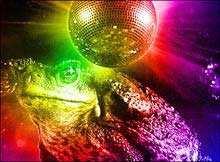The most bizarre science stories of 2005
Besides achievements, shocking events, 2005 ended with strange science stories.

Sugarcane imported into Australia is also "addicted" to the disco light
- Scientists at the University of Zurich (Switzerland) have discovered a 27-year-old female composer who can see colors and feel the taste when listening to music. This strange phenomenon is known by the scientific name synaesthesia.
- Researchers at the National University in La Jolla, California (USA) organized a dinner party and then analyzed the guests' leftovers to determine their DNA genetic structure. This application can be used to find . thieves because this object often leaves traces when "visiting" the owner 's kitchen.
- African elephants have at least one thing in common with parrots. It is the ability to imitate the sounds they hear around. Scientists in the US and Norway have come to this conclusion after discovering the case of a captive female elephant in Kenya imitating the sounds of trucks moving in a nearby road. , while a male elephant at a zoo in Switzerland mimicked the small cry of the Asian companions locked up with it.
- A group of students at Brown University (USA) invented an alarm clock that can control whims and calculate the best time to wake up the owner. However, the only obstacle to this discovery is that users must wear a cuff that attaches electrodes on their heads while sleeping.
- A.Lemaire , a 24-year-old student in Reims (France), set a world record when finding the 13th root of a 200-digit number just by calculating mental arithmetic while an ordinary person takes 48 51 seconds to complete.
- A. Haraguchi , a 59-year-old mental health consultant in Japan, set a world record when reading a circuit of 83,431 decimal digits of pi in 13 hours, breaking the previous record belonging to another Japanese with almost 54,000 decimal numbers.
- Two American insect experts paid tribute to President Bush, Vice President D.Cheney and Defense Secretary D.Rumsfeld by taking the names of these three politicians to name 3 new beetles are Agathidium bushi, Agathidium cheneyi and Agathidium rumsfeldi.
- It was discovered that a peculiar rodent species sold for meat at a market in Laos turned out not only to be a new species of creature but also the first group of a mammal line in over 30 years are waiting to be identified. It lives in stone niches so it is temporarily called a rock mouse.
- Scientists in the Northern Territory (Australia) have discovered that sugar cane toads imported into this country to kill sugarcane pests are very fond of the color of the dance hall.
- The results of a survey conducted by the British research team show that professional television programs of forensic experts can accidentally provide criminals with ways to hide from the law. Many forensic experts do not even want to cooperate with the mass media for this reason.
- The annual Ig Nobel Prize (honoring scientific discoveries that make people hug their stomachs) is a proof that scientists are also very humorous. For example, a scientist who invented an alarm clock can pull the most sleepy people out of bed by ringing constantly, then it will run away with the wheel and hide at some corner. so that the owner cannot grab it and turn off the bell.
Study whether humans swim in syrup faster than in water, analyze the electrical activity of a grasshopper brain cell while showing him the Star Wars movie and the determination of pressure in the anus of penguins when they . are also the "Nobel Prize" scientific inventions this year.
- The most bizarre science stories in 2006
- Decode bizarre stories that happen every time there is Eclipse and Moonlight
- Top 10 science stories of 2012
- 9 most sexy science stories in 2006
- The 5 most bizarre disorders in the world
- The 10 least known scientific stories of the year.
- The most bizarre burial methods in the world
- The odd misconceptions in science
- 8 incredible bizarre animals exist in the world
- 10 newly discovered scientific mysteries (Part 1)
- Japanese robot writer composed stories of the national contest
- The dark side of science
 The most famous scientific failures in history
The most famous scientific failures in history Mysterious genius mechanic and the machine froze time
Mysterious genius mechanic and the machine froze time The son carries the 'bad gene' of genius Albert Einstein
The son carries the 'bad gene' of genius Albert Einstein Isaac Newton
Isaac Newton